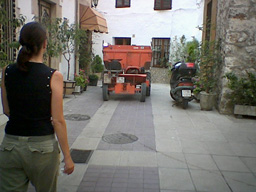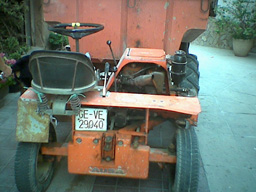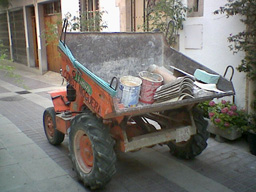July 1, 2004
Dumpers

I've written about city planning in the past, having formulated an idea of cities new and old and how scale has shifted so radically as to challenge our ideas of urban planning. The world over, there is only one idea for urban planning and this is zoning, an abstract schema of urbanism that finds its energy in cartography: the flat map where human activity is organized according to very simple graphic standards (flat geometries of lines, squares, circles... colored areas, hatching, graphic schema in general). Maybe we need a new way to image cities (Sim City, lead the way!) before we can reconceptualize how we live in them?
The critique of this (I'm thinking of Leon Krier's polemic, the simplest and most persuasive) is that human life has more dimensions that this graphic universe will allow. Krier takes the literal human body as the index for a proper scale. The attendant arguement is that physical human scale has been abandoned to the scale of the human imagination, and with this, all that is thrilling and terrifying too.
The big question is whether or not we can elect to control scale. Can we design cities that can recover the intimacies of human scale as we have long appreciated in the older city centers? Barcelona is a textbook example, a living archaeological section of the ancient city center (Bari Gotic), the cosmopolitian urban blocks of the Eixample and the suburbanized periphery typical to new cities worldwide, the spawn of Levitown and Los Angeles.
Is progress a rip tide and that a struggle against the effects of this tide (expanding human scale) is foolish and perhaps dangerous? Is the scale of the old city a nostalgia best left for tourists and theme parks? Or can human will overcome the sometimes limiting products of it's own progress and curiousity? Can we elect... to select... limits for ourselves?
These thoughts are longstanding ones for me, my own Gordian knot that has been a fierce sentry guarding the entrance to a larger, personal architectural vision.
As I was critiquing the students' porjects in Barcelona for Gerry Smulevich's and Paul Grove's class last month, I remembered these super cool little vehicles that navigate the tiny streets of Tossa. Dumpers. I realised that the scale of transportation can and should adjust to the scales of the urban fabric. The Smart Car, the moped, these dumpers, cranes (ubiquitous here in construction sites everywhere), smaller street sweepers, smaller trash trucks, little tricycle vehicles that deliver food to the restaurants. It would be interesting to try to design smaller scaled urban blocks inserted into contemporary (American) cities, and specify a suite of smaller scaled urban vehicles to service them.

This is Kiko's dumper. There are a few construction outfits here in Tossa, all have their own vehicles like this. These guys tool around on these things like they are mopeds: fast and loose. Usually, the workers are young and they dress very hip: the current style is a shaggy mohawk, sometimes natty dreads with ribbons and hair ornaments, baseball caps, spiffy sunglasses, multiple body piercings, shorts and unlaced tennis shoes.
Kiko's dumper has one cylinder, and they sound like cast iron Soviet lawn mowers. Bam, bam, bam, clankity- clank! These things race around the tiny streets ferrying debris and construction materials. I've seen others with six cylinders, customised. Swanky.

A couple of weeks ago, they had an annual ceremony where all the builders paraded their dumpers into the middle of town. Little children presented the contractors with flowers and they attended a dinner together.
Human scale is wonderful, isn't it? Can we elect to do this in tomorrow's cities... or is this a lost relic of the past?
Posted by Dennis at July 1, 2004 5:46 AM
Leave a comment